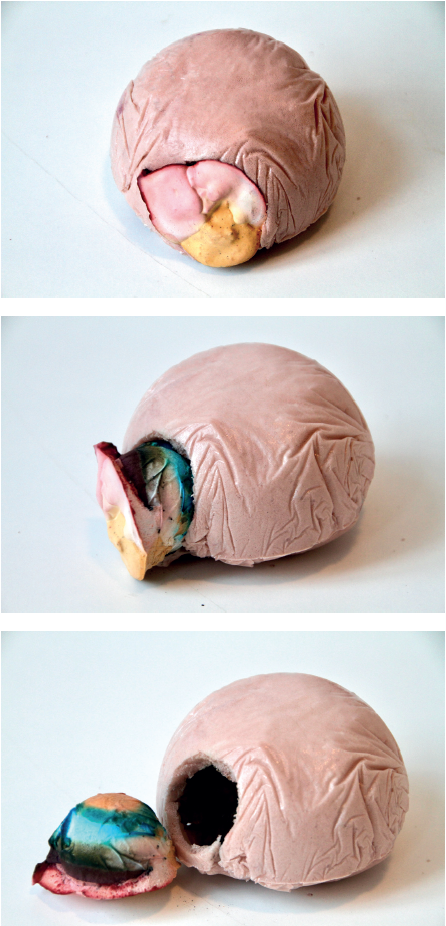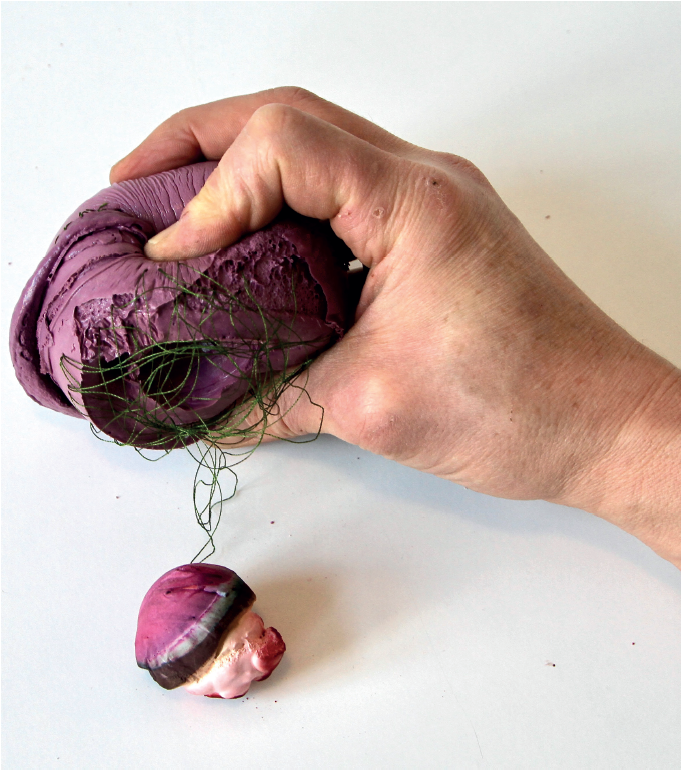This article was part of FORUM+ vol. 27 no. 2, pp. 33-42
Tactile composition
Marloeke van der Vlugt
HKU University of the Arts Utrecht, HKU Research Centre Performative Processes
Marloeke van der Vlugt creates sculptural and spatial installations that invite an audience to interact with bodies, organisms, objects and materials in a non-hierarchical manner. Her aim is to raise awareness of our reciprocal nature of being in the world. She shares the view of philosopher Jane Bennett who states that all materialities have their own form of agency and have a dynamic relation with their surroundings. To experience this open world view, her installations provide time and space for the audience or participants to explore the ‘events’ created by the reciprocal relation between their own bodies and other materialities. she employs such performance strategies as multi sensorial activation, spatial arrangement (scenography) or guided tours to activate the audience or participants to become sensitive to a world populated by animate things rather than passive objects.
Marloeke van der Vlugt creëert sculpturale en ruimtelijke installaties die het publiek uitnodigen om te interacteren met lichamen, organismen, objecten en materialen op een niet-hiërarchische manier. Haar doel is om het bewustzijn van de wederkerige aard van ons in-de wereld-zijn te vergroten. Ze deelt de visie van filosofe Jane Bennett wanneer die stelt dat alle materialiteiten een eigen vorm van agency en een dynamische relatie met hun omgeving hebben. Om dit open wereldbeeld te kunnen ervaren, gunnen haar installaties het publiek of de participanten de tijd en ruimte om events te verkennen, die ontstaan door de wederzijdse relatie tussen hun eigen lichaam en de andere materialiteiten. Ze maakt gebruik van strategieën zoals multisensoriële activering, ruimtelijke vormgeving of gegidste rondleiding, om het publiek of de participanten gevoelig te maken voor een wereld die bevolkt wordt door actieve, veranderlijke voorwerpen in plaats van passieve objecten.
Research
For my current artistic research I am exploring the tactile sense and its potential role in generating an experience that focuses on the reciprocal relationship between humans and other materialities. The sculptural objects depicted on these pages are part of this research. The intention is that they evoke in the audience a desire to touch them, imaginatively or in the real. The object may activate for instance the ‘haptic gaze’,1 meaning just caressing the surface and shape of the material with the eye already activates the sensation of touching.

When this desire is aroused, a first encounter between body and object is achieved. However, to extend this event in a non-hierarchical manner, their joint agency, as a confederation of human and nonhuman elements, is required and needs to be taken seriously. The engagement of both objects and audience / participants is necessary to explore their reciprocal relation over time.

Haptic exploration is our intentional, physical interaction with the world around us and comprises activating tactile, proprioceptive and kinaesthetic senses. The physical sensation of touch is identified by the tactile receptors in our skin perceiving pressure, pain, temperature and texture. Proprioceptors are sensors in our joints, muscles, and fascia that we need in order to produce coordinated movement for grasping an object. We use our kinaesthetic awareness (also called proprioception) – the awareness of how we move – to bring the object close to one’s skin. To interact with these objects, haptic exploration turns out to be necessary to reveal all their embedded secrets.

Touching takes – and needs – time. It slows you down. Unlike looking and seeing, which can take in vast surroundings in one glance, it is impossible to touch and immediately grasp even the tiniest object.

Process
Through research into my practice, I have been investigating the way my experience of haptic exploration of sculptural materials and crafting techniques has influenced my personal aesthetic choices during the creative process.
This has led to the development of a list of distinctive qualities that are focused on the reciprocal nature of touching materialities:
- Touching takes – and needs – time. It slows you down. Unlike looking and seeing, which can take in vast surroundings in one glance, it is impossible to touch and immediately grasp even the tiniest object.
- Touching is movement, allowing the object to play an active dimension in the process. As such both object and subject influence the temporality of the touching itself, which resembles reading a text or listening to a melody. How fast or slow, how many times, how short or long one touches is in direct correlation with the texture, layering, shape, volume, temperature, weight, etcetera of the material or object.
- Haptic exploration subverts our usual optic-spatial organisation with its fixed and exterior point of view and its linear coordinates, and evokes an internal personal spatial experience. When I solely focus on the (in)direct haptic exploration of an object, material or space, I cannot position myself at the outside, perceiving the object, material or space from a distance. My spatial experience is formed over time through the sensation of touching, step-by-step. As a result I lose my rational sense of orientation, and conception of nearby, faraway and depth and enter an intuitive space without beginning or ending.

These observations led me to concentrate on working with materials and techniques that are physically demanding, partly unpredictable and require me to train my tactile sensibility. Moreover, I realised that the process of creation and transformation of the material needs to remain visible in the final shapes: presenting traces and marks that reveal the previous tactile interaction between the materialities.
I decided to knot and tie-dye silk cloths, knit electricity wire and use it for capacitive sensing, burn, cut and sew synthetic fabrics and use these as molds for plaster, mix and pour urethane foams on various surfaces. These foams became especially interesting to me as their creation processes were never completely controllable or predictable since it is partly an invisible chemical process that creates the final shape.
These tactile creation processes forced me to take seriously the ‘vitality of materialities’, such as the material and tools I am using, the actions of my arms and hands, and the space in which I am working. With the word ‘vitality’ Jane Bennett points to: ‘The capacity of things to not only impede or block the will and designs of humans, but also to act as quasi agents or forces with trajectories, propensities, or tendencies of their own’.2

I realised that especially during the preparation phase, while handling, molding the material, my haptic exploration becomes a proper dialogue with the material, as it acts as much as a companion as it is resistant.

My haptic exploration within the creative process demands focus and engagement and reveals the reciprocal nature of my interaction with materialities; I cannot touch without being touched in turn, as philosopher Erin Manning emphasised.3 As a result my haptic exploration transcends the sort of interaction in which subject and object are seen as two separate unities and facilitates what feminist theorist Karen Barad calls ‘intra-action’,4 where object and subject become fluid and are constantly changing in the moment.
Returning to my practice, in the moments when I truly submit myself to haptic exploration – getting into a physical, tactile dialogue with the object, materials or persons – I experience an opening up of an intuitive or mental space without preconceptions or clear intentions. It is a space within which my affective, emotional, mental responses are constantly changing as a result of being in direct interaction with the ‘who or what’ I am touching. It is challenging to stay in this place of the unknown and allowing the materialities to exert their power. Touching is never symmetrical: a friendly tap can be perceived as perogative or even damaging to another (non)human being. In addition, one can never fully predict how the dialogue will develop. When I do manage to do so, other creative possibilities open up, possibilities that are not solely initiated by me, and a “new” understanding of myself in relation to the object, the material or the other does appear.

+++
Marloeke van der Vlugt
Marloeke van der Vlugt is a Dutch artist and researcher. She graduated from the University of Amsterdam with a practice-based research project about the relation between space, movement and body (interrelated thesis and performance). Van der Vlugt studied Scenography at Goldsmith’s Academy and Choreography at the Laban Centre, both based in London. She specialised at DasArts (Amsterdam School of the Arts), combining theoretical and hands-on knowledge on the relationship between body and technology. She now works as an autonomous artist and director of interactive, performative installations that research our embodied relationship with the world. Marloeke is currently affiliated with HKU University of the Arts Utrecht as a tutor, and with HKU Research Centre Performative Processes as a researcher.
info@marloekevandervlugt.com
www.marloekevandervlugt.com
Images: Marloeke van der Vlugt, thanks to Esther Mugambi
Footnotes
- Sobchack, Vivian. Carnal Thoughts. University of California Press, 2004. ↩
- Bennett, Jane. Vibrant Matter. Duke University Press, 2010. p. 8 ↩
- Manning, Erin. Politics of Touch: Sense, Movement, Sovereignty. University of Minnesota Press, 2007. ↩
- Barad, Karen. “Posthumanist Performativity: Toward an Understanding of How Matter Comes to Matter.” Signs: Journal of Women in Culture and Society, vol. 28, no. 3, 2003, pp. 801-831. ↩


